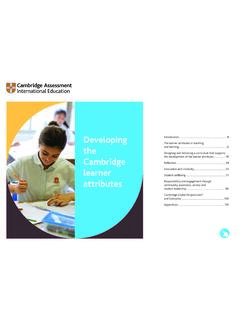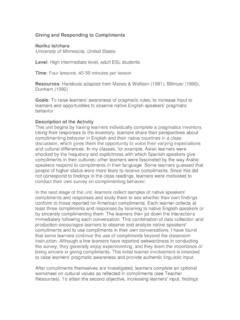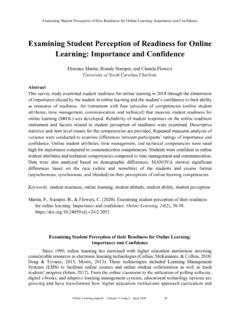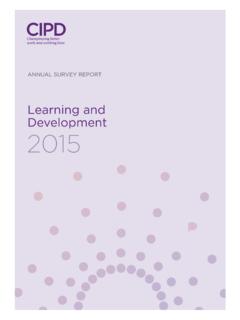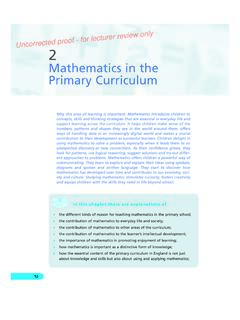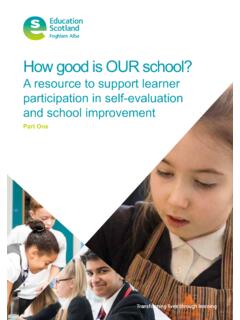Transcription of The Challenges of Online Learning Supporting and …
1 Journal of Learning Design Gillett-Swan 2017 Vol. 10 No. 1 Special Issue: Business Management 20 The Challenges of Online Learning Supporting and Engaging the Isolated Learner Jenna Gillett-Swan Queensland University of Technology Abstract Higher education providers are becoming increasingly aware of the diversity of their current and potential learners and are moving to provide a range of options for their engagement. The increasingly flexible delivery modes available for university students provide multiple pathways and opportunities for those seeking further education. In changing between and across modes, a one-size-fits-all approach is often used. That is, internal content is converted into a form deemed suitable for an external delivery. However, there is a significant problem with the one-size-fits-all approach for external students who feel or experience isolation. When compared to their internal counterparts, these students often face a number of barriers to their full participation in coursework units.
2 These barriers may not be experienced by those engaging in these same units via face-to-face or blended enrolment modes and therefore present another type of learner to consider in the planning and implementation of Learning activities Online . The barriers to participation appear particularly evident in groupwork activities. The Online environment also presents Challenges for many academic staff who increasingly require higher levels of technological competency and proficiency on top of their regular academic workload. Drawing on reflections of several years of facilitating student Learning Online , this paper provides one lecturer s perspective and critical commentary on some of the Challenges faced by external students and the implications of an increasingly Online delivery framework for practice. Keywords external students, isolated learners , technology, Challenges , Online Learning , competence Introduction Higher education providers are becoming increasingly aware of the diversity of their current and potential learners .
3 This is demonstrated by their providing a range of options for their engagement. Increasingly flexible delivery modes are available for university students provide multiple pathways and opportunities for those seeking further education (Boling, Hough, Krinsky, Saleem, & Stevens, 2012; Napier, Dekhane, & Smith, 2011; Schmidt, Tschida, & Hodge, 2016). This could be through traditional face-to-face delivery (internal), Online (external), or mixed (blended) modes of enrolment. Even within these enrolment modes, students often opt to undertake different units (subjects) in different ways (Schmidt et al., 2016). As universities increasingly move towards fully Online and blended teaching modes, there is much discussion as to what this means for pedagogy (Gregory & Salmon, 2013; Jaques & Salmon, 2007; Kirkwood & Price, 2014; Salmon, Journal of Learning Design Gillett-Swan 2017 Vol. 10 No. 1 Special Issue: Business Management 21 2011, 2014). While many of the practices that are used in face-to-face contact modes can be adapted and utilised in the Online context, it is not simply the case of applying a one size fits all approach which is what teaching staff relatively unfamiliar with the Online environment tend to do.
4 This is where either the content or delivery used in other, usually face-to-face contexts, is adapted to a seemingly compatible Online format and therefore deemed suitable for all learners and cohorts across each mode. Instead, scales of adaptation and differentiation within the approach should be used to better differentiate between different learners as well as different contexts of teaching via Online and live modes. When it comes to technology, Orlando and Attard (2015) stated that teaching with technology is not a one size fits all approach as it depends on the types of technology in use at the time and also the curriculum content being taught (p. 119). This means that the incorporation of technology provides additional factors for consideration in terms of teaching pedagogy and construction of Learning experiences. Despite this, it is often taken for granted that technologies can enhance Learning (Kirkwood & Price, 2014, p. 6) with the prevailing assumption becoming that technological incorporation, Learning enhancement, and student engagement are mutually and inextricably linked.
5 However, in creating individually tailored differentiated instruction for each learner within and across each cohort, additional workload pressures on those seeking to engage with the Online environment can be created as teaching staff seek to respond, often reactively, to the individual Learning and engagements needs of each cohort. The problems with a one size fits all approach are particularly highlighted in collaborative Learning tasks (group work) where individual differences between and across cohorts can be highlighted. This may be because the generalised pedagogical assumptions associated with collaborative Learning tasks are often applied to the Online environment where there may be less focus on the delivery and more attention to the task/content (Graham & Misanchuk, 2004). Therefore, the assumption that students will both know and be able to work in groups regardless of mode prevails through a seemingly universal one-size-fits-all application.
6 In addition to the typical Challenges that students can experience in group activities regardless of mode, the Online environment presents added Challenges for the external or isolated learner particularly through considerations around their engagement, access, community, and support. In reflecting on a lecturer s perspective for facilitating Learning Online , this paper offers strategies for those preparing to teach in an Online environment focused around pedagogical strategies for Supporting learners through the development and facilitation of group presentation collaborative Learning activities. Based on several years of experience, the following insights are provided to encourage those with uncertainty or inexperience in facilitating an Online Learning environment a starting point so that they can understand and support their learners . The isolated learner The barriers to participation that external students may experience are particularly evident in collaborative Learning tasks through group work, group presentations and group assessments (Davidson, 2015; Graham & Misanchuk, 2004; Jaques & Salmon, 2007).
7 Some of the issues experienced can be personal such as: anxiety associated with using technology; being out of one s comfort zone; (perception of) inequity in assessment, particularly in group assignments; and, the (perceived) inability or difficulty in peer interaction, particularly in presentations. Despite the best intentions of teaching staff to provide equitable and beneficial Learning experiences for all students, regardless of enrolment mode, many academic staff members feel apprehensive and not suitably equipped to teach via wholly (or mostly) Online particularly as they themselves may be still Learning to use some of the platforms (Jaques & Salmon, 2007; Little-Wiles & Naimi, 2011; Rucker & Downey, 2016; Schmidt et al., 2016; Thorsteinsson, 2013). This can leave learners in an isolated place where they may also have varying levels of competency and proficiency using different forms of IT and are therefore somewhat on their own when it comes to the Online Learning environment through different Learning Management Systems (LMS).
8 This is particularly highlighted in collaborative Learning tasks where individuals may be barely managing to navigate the system on their own, let alone needing to traverse the complex environments of group Journal of Learning Design Gillett-Swan 2017 Vol. 10 No. 1 Special Issue: Business Management 22 interaction and social negotiation (Graham & Misanchuk, 2004; Jaques & Salmon, 2007). While group work is an important element within education that aids in developing numerous interpersonal and transferable employable skills, an increasing number of potential hurdles to achievement beyond those commonly associated with traditional group work experiences may serve to further alienate isolated learners causing their disengagement, withdrawal, or ultimate exclusion from engaging with and accessing the course materials and associated Learning activities. While the Online environment provides opportunities for the ways education is delivered and accessed by learners , assessment practices are often limited in the variety and modes in which they are allocated in the Online environment (Williams, Cameron, & Morgan, 2012).
9 For example, where group presentations within the tertiary environment have been traditionally conducted via predominantly face-to-face mediums (Cazan & Indreica, 2014; Milman, 2014; Napier et al., 2011), the Online environment presents additional opportunities for summative assessment with group presentations (Jaques & Salmon, 2007; Park & Bonk, 2007; Williams et al., 2012; Zapalska & Brozik, 2006) that are not limited to a solely live option. Even so, Online group presentation assessments do not appear to be common practice which may be due to some of the difficulties experienced by both students and academics in using an Online delivery platform (Jaques & Salmon, 2007). This is where the sharing of good practice and lessons learned among members of the higher education community can help academic teachers concentrate on effective uses of technology and to avoid the unnecessary duplication of effort and expense (Kirkwood & Price, 2014, p.)
10 7). University students choosing to undertake study Online have indicated a preference for Online assessment and often perceive their Learning experiences to be enhanced through Online media (Boyles, 2011). However, the preferences may be different for those with limited choice in delivery mode because of additional work or the family commitments that may restrict their ability to engage in alternative and perhaps preferred face-to-face or blended enrolment modes (Stoessel, Ihme, Barbarino, Fisseler, & Sturmer, 2015). Within the context of pre-service teacher education, the implementation of Online assessment also serves to enhance their knowledge and understanding of ways to use new technologies in their future teaching practice (Blackley & Sheffield, 2015; Boyles, 2011). Extending this, it might also provide preparation for Business graduates in their future participation in Online meetings or collaborations. This experience, in turn, provides additional benefits for student Learning beyond the unit level.










